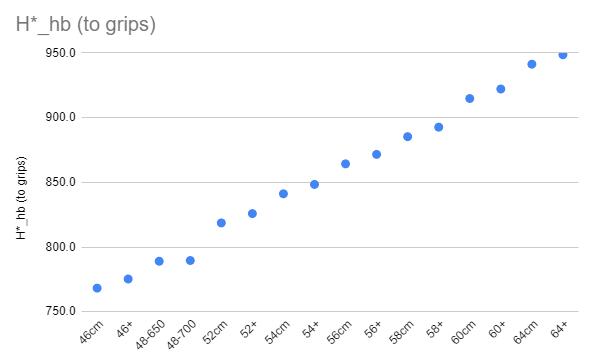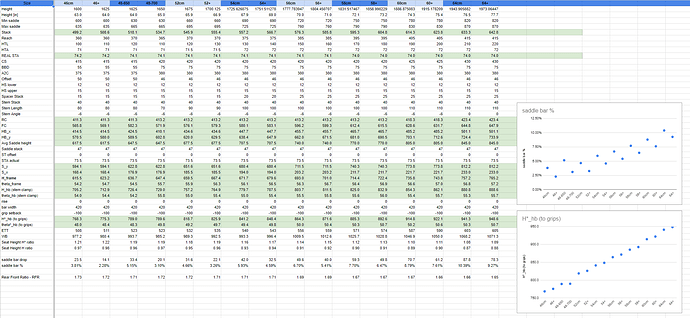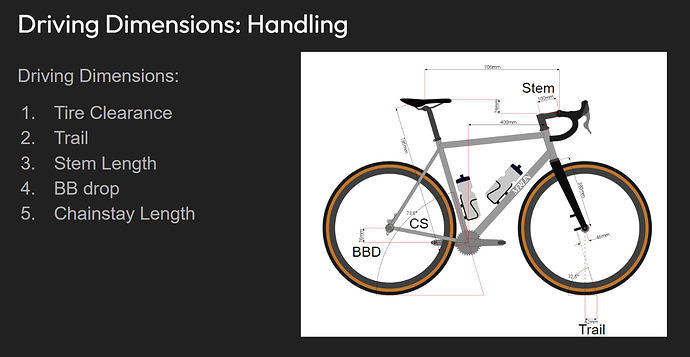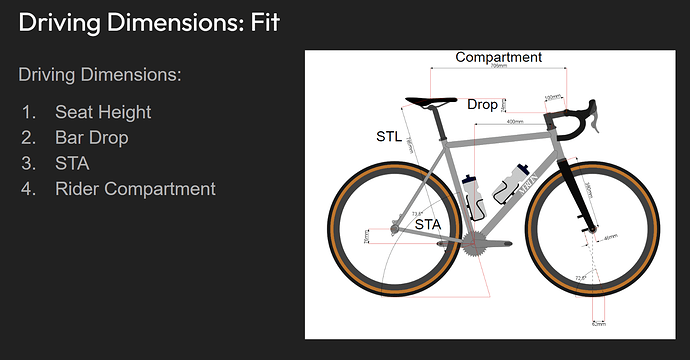Hi,
what dimensions do you think should not be changed / somehow preserved when designing various sizes of the same bike - to have similar ride quality? Maybe there is some reading you could recommend? Thanks.
What style of bike are you discussing? Road? Gravel? Mountain hardtail? DS?
Well, I’m into road/gravel but I’m looking for some general thoughts.
Are you looking for thoughts centered around “best ride”, “best compromise” or “best efficiency?”
The PoV from a Product Line Manager is very different than from a custom frame builder or from a small/niche brand.
I think something between best compromise and best efficiency from a small builders’ view.
I try to keep everything constant across all sizes. But you end up with certain trends across the size spectrum due to:
- wheel and component availability
- rider expectations
- marketing/consumer expectations
Things I try to keep constant:
- the bar drop to saddle height ratio
– This determines the stack height
– gravel example: Saddle to bar drop ~8% of saddle height - Trail (handling characteristics)
- Front-rear weight ratio
– this determines the chainstay length
– I try to keep this constant on mountain bikes, but it ends up varying due to component availability and consumer expectations - aestetics
Things I scale proportionally:
- “hypotenuse” (sqrt(stack^2 + reach^2)
- bar width
- crank length
- wheelsize
- tube spec
For example, this is the massive spreadsheet that I use to design sizing ranges. I look at things like bar drop, hypotenuse (stack and reach), and front-rear weight ratio.
Nothing is ever constant (horizontal line) or perfectly linear as the size range changes. There is definitely some fine-tuning and massaging of the numbers to get bikes to look right and meet people’s expectations.



Additional reading:
I would take the RAD discussion with a grain of salt. I think their methodology is good, but their conclusions are based on too narrow of a view.
Here are some related slides:
I think to best understand sizing adjustments, you need to have a really good handle on what makes a bike feel like “this bike” and not “that bike”. If you can take a set of parameters (trail, reach/stack, CS length, tube choice for example, or however you would normally define your design for a given size) and say “I expect this bike to function with X, Y and Z characteristics” then it should pretty easy to extrapolate to bigger and smaller sizes. I guess the hard parts are a) knowing how to do that in the first place, and b) knowing what proportions to aim for with a given rider body geometry.
Find a bunch of mass-production bikes that are similar to what you’re working on and look at their geometry charts - you probably shouldn’t copy directly but you can get a good idea of where to start. Also look at ratios between given parameters, eg trail:wheelbase (hat tip: @BS_Industries post in the 14" kids bike thread).
@Daniel_Y I truly appreciate the work and knowledge you put in your posts here. Thanks. It’ll take me now probably a year to understand all of this ![]() What you wrote is somehow is similar to what my intuition tells me, but puting it in numbers is a challenge.
What you wrote is somehow is similar to what my intuition tells me, but puting it in numbers is a challenge.
@JoeNation I think (hah) that I have “the feeling”, but would like to put in numbers at least a bit. I’ve already looked through some mass production stuff, but - big producers usually have marketing and accountants messing around the process, so optimal geometry be a bit “obfuscated”.


